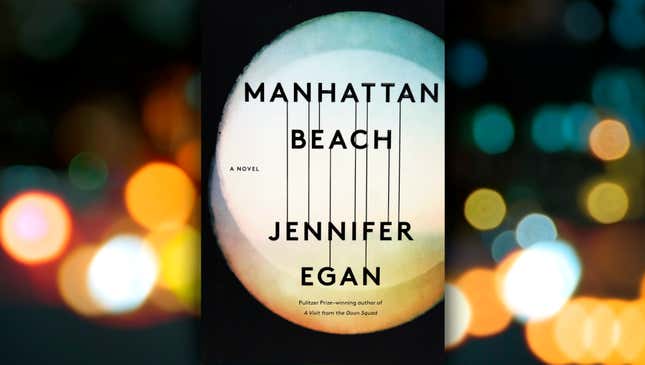
If some themes are universal—if a story about family ties or perseverance can be set in any time period—why write a historical novel? One reason is to use the past to say something new or compelling about the present. Another might be to reveal a previously unknown story about a particular era. In Manhattan Beach, a sweeping WWII-set novel, Jennifer Egan relates the life of protagonist Anna Kerrigan, the first female ship-repair diver in the Brooklyn Naval Yard. While the narrative may offer the novelty of deep-sea ship repair in the Rosie The Riveter age, the book stops there, leaving contemporary readers without the kind of surprising thematic significance that makes historical novels feel necessary.
Needless to say, as the first female anything, Anna encounters obstacles far beyond underwater currents and 200-pound diving dresses. But she is the familiar heroine who will get saddled with adjectives like “spirited” and “plucky,” the quintessential headstrong female character in a male-dominated world. She muscles her way into her position as diver, standing up to her misogynistic lieutenant, and exercises sexual agency throughout. As is often the case with such heroines, she has found independence out of necessity: Her father, Eddie, has disappeared, and Anna must support her mother and sister, Lydia, who has severe physical disabilities. Unlike her father, who became a bagman for corrupt union officials to provide for his family, Anna operates within the shifting norms of wartime America. Another way to put it: Her father breaks the rules, while she breaks with convention.
The novel, by its very structure, welcomes these comparisons. When the third-person narrative turns from Anna, it alternates, seamlessly, between her father and Dexter Styles, a nightclub owner with his own under-the-table business and who goes on to employ Eddie. (In the novel’s opening, an adolescent Anna accompanies her father to Dexter’s mansion for the men’s first meeting.)
As Anna matures without her father, the prose around her emotions sharpens, as when she sees Dexter in one of his clubs and realizes he may know something about her father’s disappearance. The writing also finds life in a late-novel interlude depicting sailors aboard a merchant marine ship and a short affair on land. Egan offers this prelude to the latter: “Men ran the world, and they wanted to fuck women. Men said ‘Girls are weak’ when in fact girls made them weak.” While this rings with revelatory truth to the man thinking it, today’s readers may not find it so insightful.
It can take a while to get to Manhattan Beach’s best moments. In A Visit From The Goon Squad, Egan’s highly praised Pulitzer Prize-winning novel, her innovative form allowed for frequent peaks, each of its 13 connected sections focusing on a particular moment in a character’s life; the prose was potent, nearly shaking with energy. Manhattan Beach delivers (what can feel like requisite) character crises and turning points, yet the story stretches out long and wide, and a little too evenly, weighed down with extra detail and setup.
Similarly, Egan adeptly weaves in an immense amount of research—on the era’s slang, dress, naval repair, and life in the merchant marines—and as in her other work, she makes it look easy. Yet writing so skilled can disguise what’s missing. Reading this book can feel like walking through an elegant and impeccably decorated home, wherein every trinket and artwork is expertly placed, the mess of life hidden away. It’s easy to recognize the care and skill of the place, but it doesn’t excite or disturb.
Egan’s impeccable Manhattan Beach houses substantial concerns: the evolving relationships within families, social codes in the hypermasculine worlds of crime and the sea, homophobia, racism, and especially sexism in mid-century America. “Loosening a knot always seemed impossible until it was inevitable,” Egan writes, describing Anna’s pre-diving test. “The knot made a last clutching effort to preserve itself, its reluctance to yield making it seem almost alive. Then it surrendered, the cords loose in her hands.” It sounds like the labor that so many women, spirited women even, have done and do to slowly dismantle a system that would oppress them. Men make the knots, and women work to untie them. In our contemporary moment, for better or worse, this isn’t news.
Purchasing Manhattan Beach via Amazon helps support The A.V. Club.